
Topological Materials - C. Shekhar
Topological materials have newly been identified as quantum materials and their properties are highlighted by topology. Topology is a branch of mathematics where properties of objects that are invariant under smooth deformations are studied. Materials properties which are invariant under topological transformations property are known as topological materials. Topological insulators (TIs) are insulating in bulk and conducting at surface. In another class of topological materials, the bulk of the material is semimetal and their valence and conduction bands touch at near Fermi level. Depending on whether the bands are nondegenerate or doubly degenerate, topological material is called a topological Weyl semimetal or a topological Dirac semimetal. Properties of topological materials indicate the existence of Majorana, Weyl and Dirac fermions. Many of the compounds containing chalchogens and pnictogens have shown exotic properties e.g. FeAs-based high temperature superconductors, topological insulators, Weyl and Dirac semimetals, graphene analogues (transition metals chalcogenides) etc.
Our group expertise in single crystal growth and transport measurements achieves synergy to realize new properties of materials by theoretical collaborations. We also welcome worldwide collaborations having similar or different thoughts and interests. The full list of single crystals and a request form can be found on TOPMAT.
Flux growth
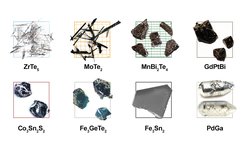
For the successful growth of single crystals requires the sufficient diffusion of atoms. A flux that can dissolve constituent elements at relatively low temperatures can be effective to grow single crystals from the solution. Once the liquid reaches the saturation limit during cooling, crystal growth is initiated. The excess flux can be removed through simple decanting or centrifugation before the melting point of the flux. The facets of optimally grown crystals are well developed and can easily be recognized from their shapes. Depending on the bonding anisotropies in a compound, crystals can take the forms of wires, ribbons and polygons.
Bridgman
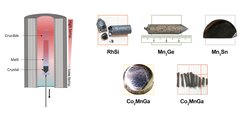
Another excellent process for synthesising thermodynamically stable structures and compositions by this method. The method is a perfect choice for the congruently melting compounds and for the materials that do not undergo phase transition. Generally polycrystalline material is loaded in a crucible with sharp conical tip geometry and heated it above the melting temperature and the crucible is then translated slowly into the cooler zone of the furnace with a constant translation velocity from the hot zone to the cold zone of the furnace.
Laser/Optical Floating Zone
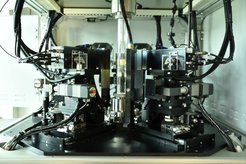
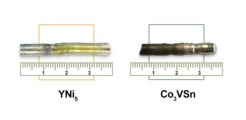
The floating zone technique is a crucible free method that avoids the contaminations during the single crystals. We employ both laser and optical furnaces procured from Crystal Systems Inc., Japan. Depending on the heating source, the maximum temperature can be reached to 2600 oC. Utilizing various flexible parameters e.g. temperature, growth rate, shaft rotation, pressure etc., the required phase for crystal growth can easily be achieved and tuned.
Chemical Vapour Transport (CVT)

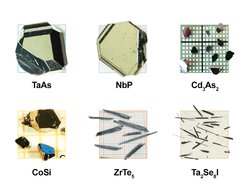
Chemical vapour transport (CVT) is a process where a condensed phase, typically a solid is volatilised in the presence of a gaseous reactant (transport agent) and deposited elsewhere in the form of crystals. Depending on the free energy of the reaction between the species, the source and sink temperature must be altered. A reaction that is exothermic indicates transport from cold to hot zone and the reverse is expected for an endothermic reaction. Also, if the reaction between the species is highly exothermic or endothermic, no transport takes place.
Single crystals of transition metal dichalcogenides (TMD) and pnictides have been obtained by this method.
Report 2021
“Topological Magnetic Heuslers”
Report 2021
“Chirality and fermions”
Report 2021
“Kagomé Compounds”





